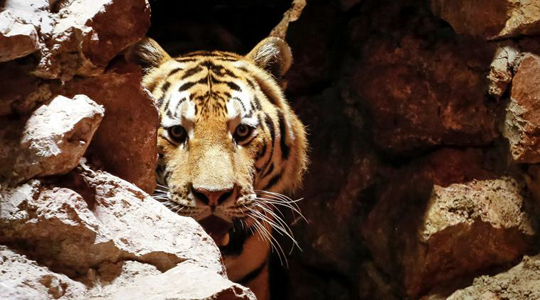New Delhi, Sep 25: About 7.2 lakh trees and a huge 90 square kilometres area of Panna Tiger Reserve (PTR) may be submerged in water due to the Ken-Betwa river linking project, according to an official report.

There will be also be an "irreversible" loss of breeding sites for wild animals after submergence of critical and specialised habitats under the proposed project which is likely to cost over Rs 9,000 crore.
The Ken-Betwa project is expected to provide drinking water supply for 13.42 lakh people and help irrigate 6.75 lakh hectares of land in the poverty-ridden Bundelkhand region covering parts of Madhya Pradesh and Uttar Pradesh.
The project is founded on construction of a dam at Dhaudan village inside the PTR's core area in Chhatarpur district of Madhya Pradesh.
"The entire forest area under the proposed submergence both within and outside PTR is tiger habitat, while the non-forest area is potential tiger habitat. Thus, about 90 sq km area of tiger habitat, including potential habitat, will have to be considered as submergence zone," National Board of Wildlife (NBWL) Standing Committee report on Ken-Betwa link project said.
At present, there are around 35 tigers in the reserve, which had in 2009 reported extinction of the big cats.
The report, which has been submitted to Union Environment Ministry, said the total counting of trees in the proposed submergence area has not been done, but a sample survey by the forest department has estimated that "about 7.2 lakh trees above 20 cm girth at breast height would submerge in the national park area and this number may go up to about 12 lakh stems when young poles and established sapling are accounted".
It said an equally high number of trees will be cut or lost in the forest areas outside the national park. "Thus considerable quantity of carbon stored as biomass would be released once the dam is constructed, in addition to loss of vegetation diversity," said the report, a copy of which was received by wildlife activist Ajay Dubey in response to an RTI query filed by him.
He said the National Green Tribunal and appropriate court will be approached to challenge the proposed project on the basis of the report's findings. The report said Panna Tiger Reserve has largely been valued with respect to the requirement of the tiger.
"The importance of other key wildlife such as sloth bear, leopard, rusty spotted cat, hyena, sambhar, chital, four-horned antelope and chinkara are largely ignored under the shadow of tiger, although tiger conservation may support the conservation of its associated fauna. Ken river along with its tributary is a lifeline of the park. Ken river basin is full of gorges, caves, rock crevices which are normally occupied by wild mammals for breeding and resting.
"During hot days in summer, these gorges, caves, rock crevices are major shelters for some of the animals listed above. Loss of breeding sites will be irreversible after submergence of these critical and specialised habitats, specifically in the major submergence zone," it said.
The blasting of stone quarries, use of heavy machinery, movement of heavy vehicles and presence of over 500 workers (at a time) for construction are some of the "major concerns", the report said.
"Given that the region (Bundelkhand) is poverty-ridden, the realised benefit of the project cannot be ignored and that there would certainly be a need to strike a balance between wildlife conservation and people's livelihood considerations," it said. The estimated cost of Ken-Betwa project is Rs 9,393 crore.





Comments
Add new comment